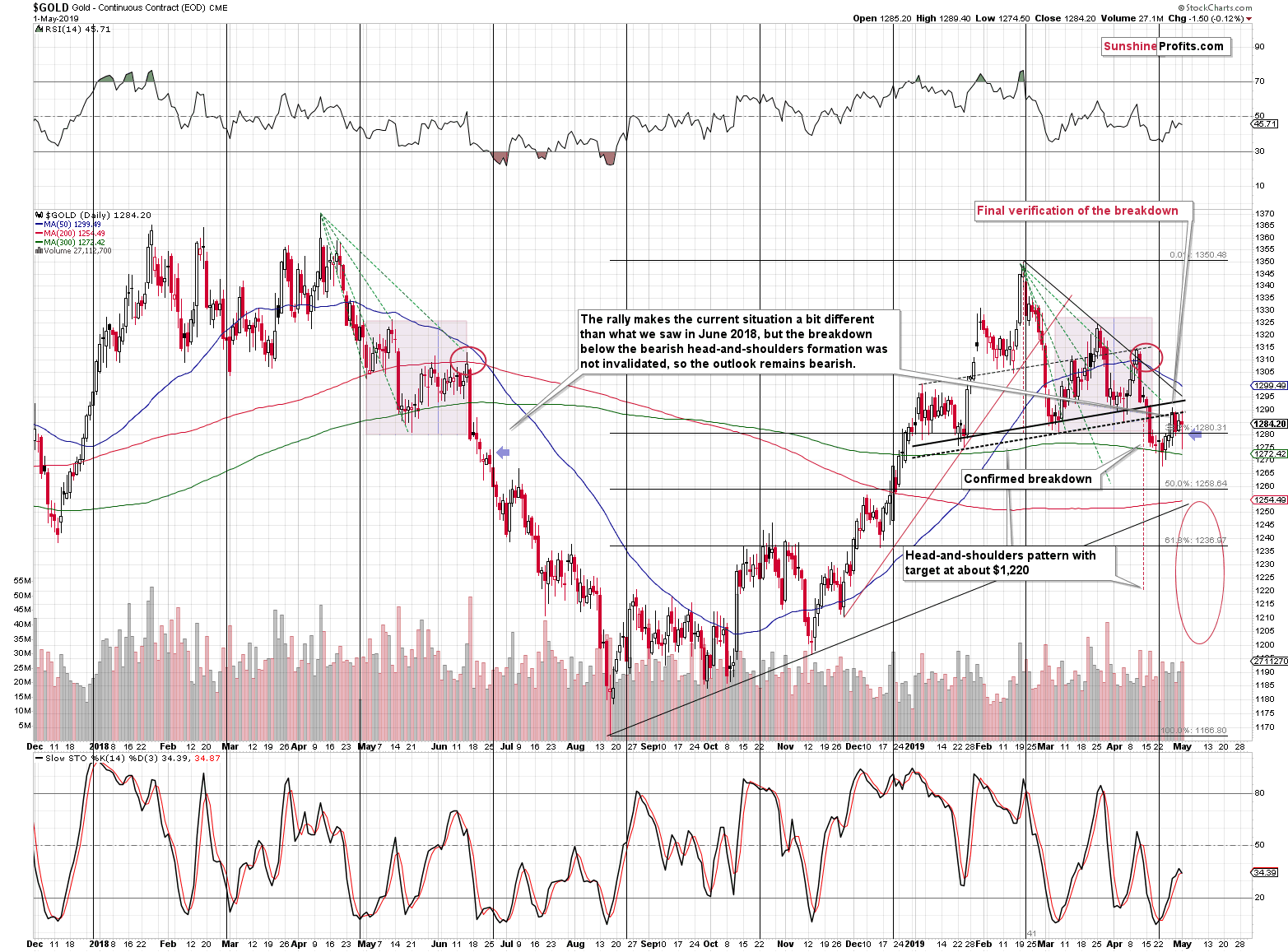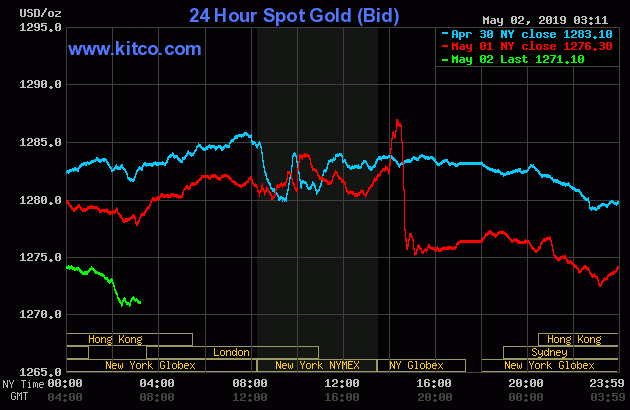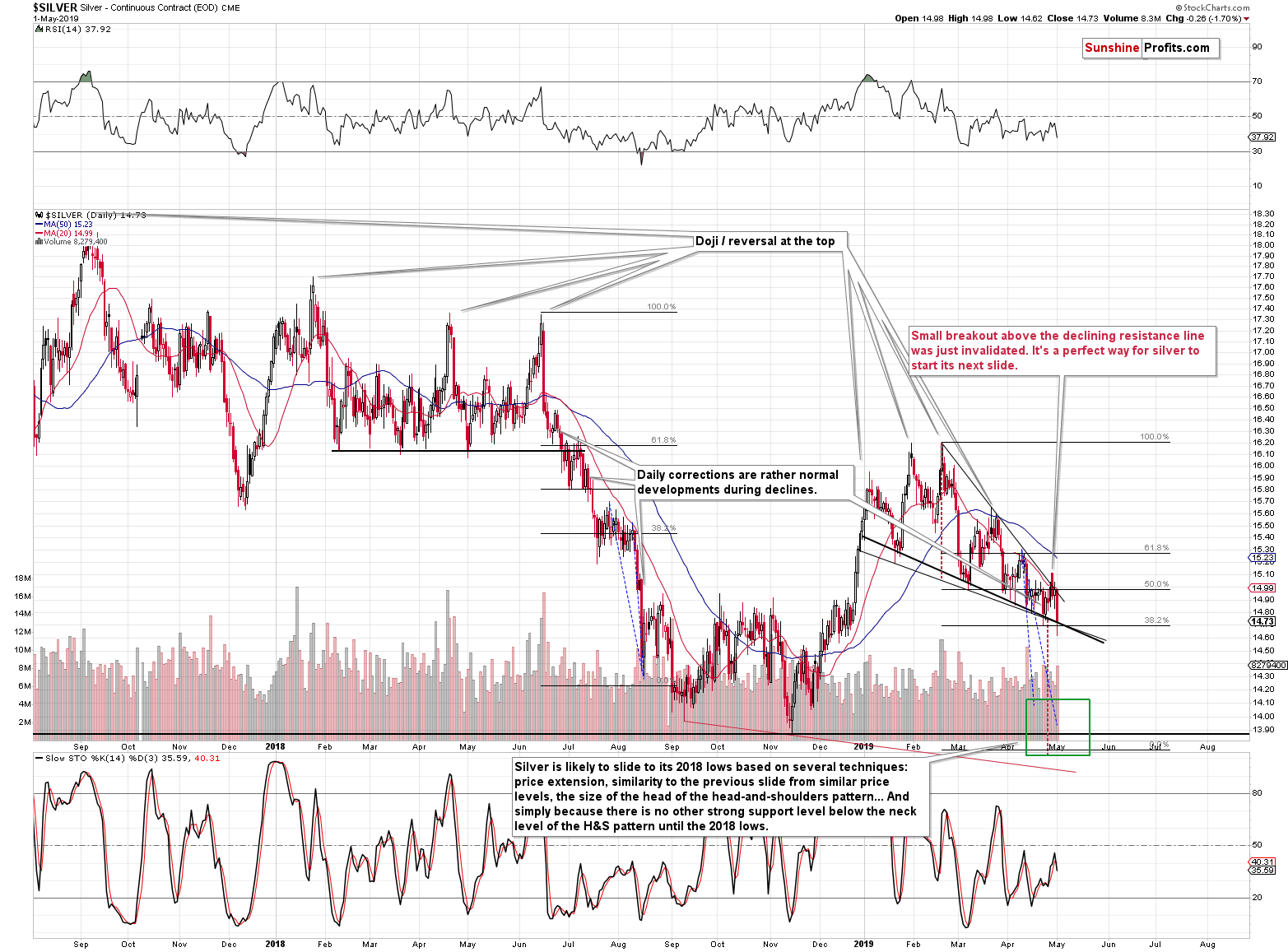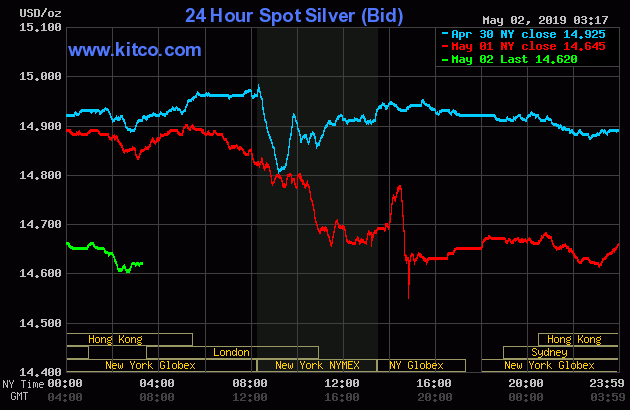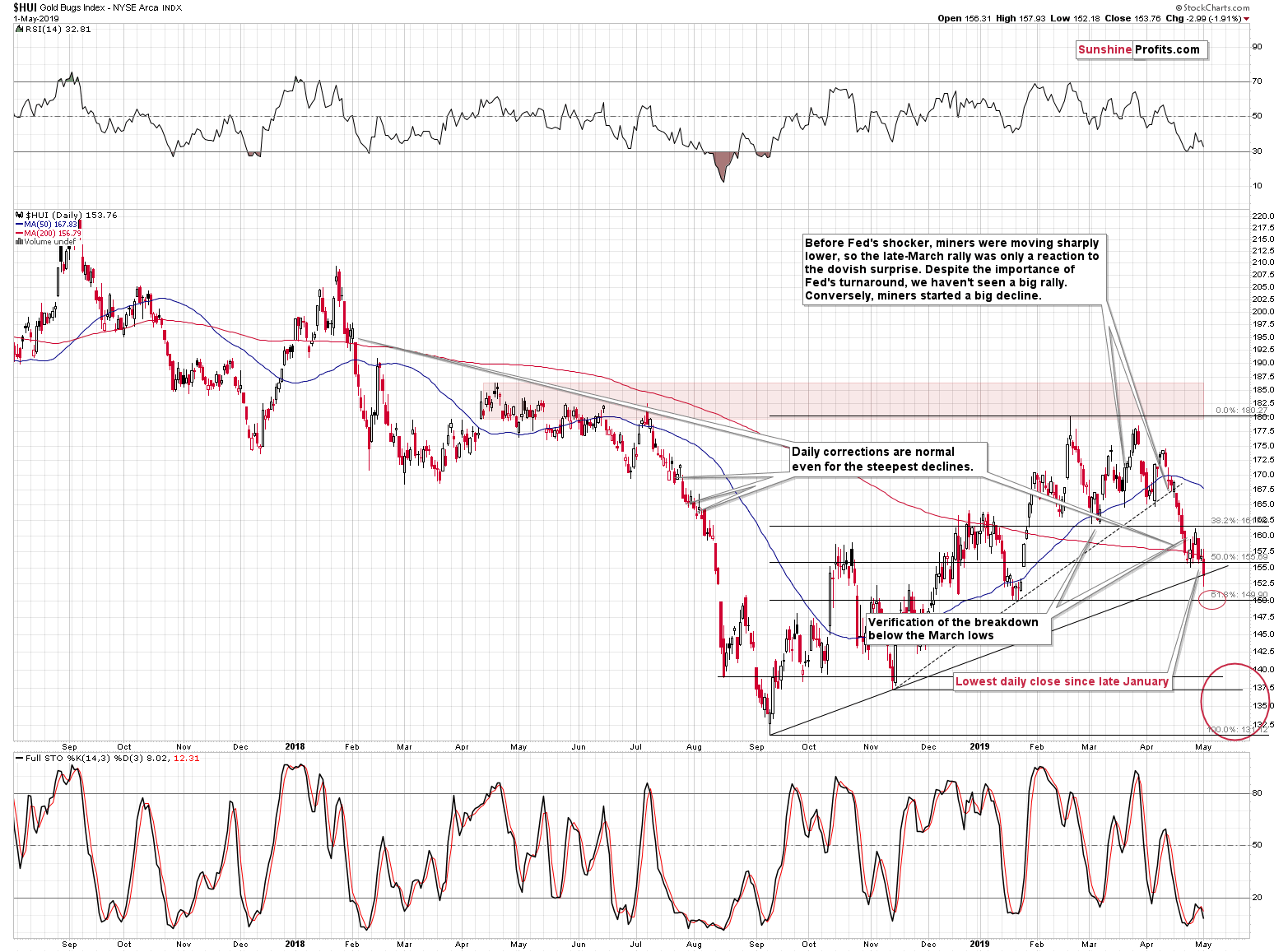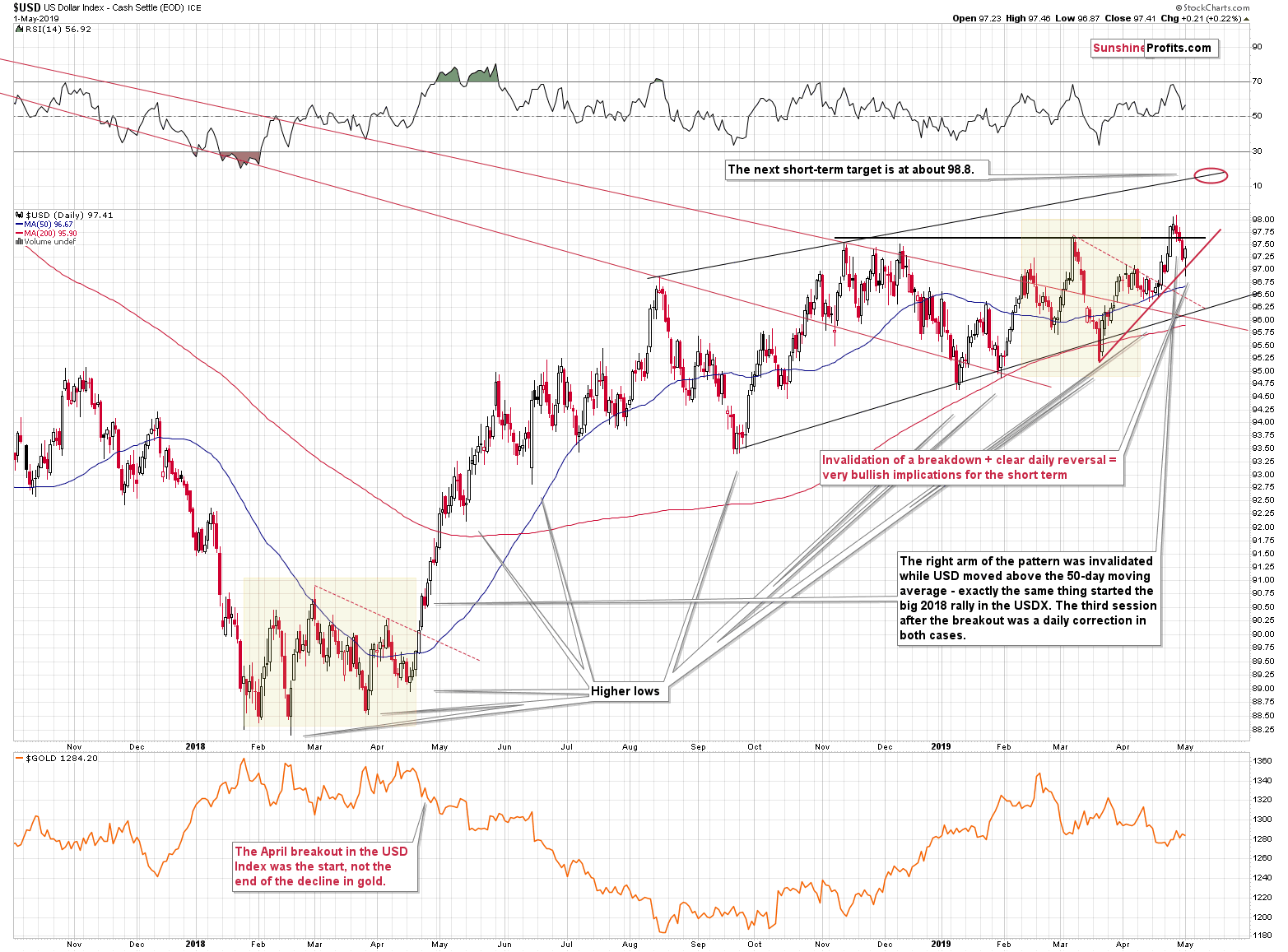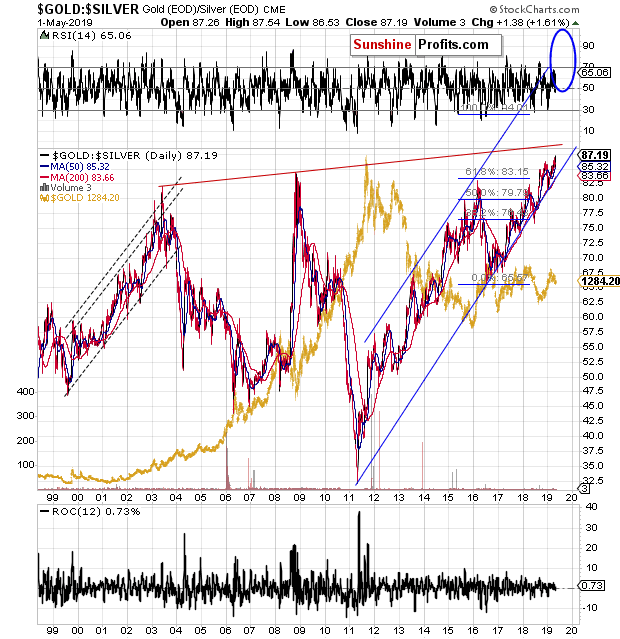Briefly: in our opinion, full (250% of the regular size of the position) speculative short position in gold, silver, and mining stocks is justified from the risk/reward perspective at the moment of publishing this Alert.
And so, it happened. Silver broke to new 2019 lows, while miners moved below their April lows. Gold seems to have given the head-and-shoulders top pattern the farewell "kiss" and is now on its way to new lows. The USD Index formed a perfect bullish reversal. All that happened while the final near-term uncertainty-based dam was broken. The Fed spoke and nothing really major happened. This is critical, because now the markets expect no additional surprises (remember the late-March shocker?) and they're back to business-as-usual. In other words, the previous trends can now resume. In case of the USD Index, the trend is up, and in case of the precious metals market, the trend is down. Very much down.
Starting with Gold
What we can see on the above chart is that gold moved once more to the neck level of the head-and-shoulder pattern before declining. What we don't see is the full size of the decline.
Gold is about $15 below yesterday's intraday high, which means that it's testing the April lows. At the same time, the USD Index is not yet trading at its April high. Taken together, both facts confirm what we have indicated earlier - gold is multiplying USD's bearish moves, while mostly ignoring the bullish moves. This gold-USD link gives a very bearish sign for the following days.
Continuing with Silver
Silver declined profoundly and it's currently trading very close to yesterday's intraday low.
This means that the white metal is trading below the declining support line and thus we are seeing a breakdown in progress. This breakdown is likely to lead to a sharp decline - quite likely this week. There are only two more sessions before the trading week ends but given the pace at which silver tends to slide, it would not be surprising or uncommon to see it at $14 shortly.
Let's keep in mind that when silver reverses close to $14 (please note that it can decline temporarily below it) and starts to move higher, it will most likely only be a relatively small corrective upswing, nothing more. The correction probably wouldn't take silver above the current levels. Perhaps it won't even manage to get as high.
Miners Are Leading the Pack
Gold stocks declined and broke below their April lows in a way that was even clearer than what we saw in gold or silver. Unlike silver, miners didn't yet reach new 2019 lows, but it seems that they are very close to such a move. Still, 2019 is already a down year for the miners.
The huge daily breakdown in gold stocks despite an analogous move in gold is yet another crystal-clear sign that the entire precious metals sector is about to slide further.
On April 23, we have moved the profit-take levels of the current short positions lower, arguing that if gold was to slide to $1,240, then the degree of underperformance in the miners justified targets that were well below our previous target area of 150 - 152.5. This turned out to be a good move, because this target area was already reached yesterday, and gold's decline is only beginning. The yellow metal has yet to decline based on the head-and-shoulders pattern and this move is likely to take gold miners much lower as well.
The USD' s Reversal
The USD Index moved lower yesterday, broke below the rising support line and then came back up with vengeance, invalidating the breakdown and forming a bullish daily reversal. It's hard to find with a more meaningful daily sign with such bullish implications.
So, we now have a situation, where the USD Index is likely to rally. Gold is likely to magnify this move and in turn, silver and mining stocks are likely to magnify gold's move to the downside. Miners because of their natural tendency to underperform during downswings, especially in its early and middle part. Silver, because of the recent breakout in the gold to silver ratio. This is a very powerful and bearish combination.
The Gold to Silver Ratio
Speaking of which, we have decided to feature it once again, because we have read elsewhere about the situation being bullish for the precious metals sector, because the ratio is in its so-called "80s resistance zone".
This is ridiculously incorrect. The gold to silver ratio is not in the resistance zone. It's after a breakout above the resistance and the breakout has been more than confirmed. No other attempt to break above the 80 level that we have seen in the past two decades has taken the ratio this high and kept it there for so long. We are not just telling you that this time will be different. This is a proof, one of many, that this time already is different. The ratio has been trading above 80 for months now - nothing like that has happened previously.
This is not a situation where the ratio moves or stays at the resistance for a long time. It's a confirmed breakout with very bullish (for the ratio) implications. The consequences for the precious metals sector are very bearish, not bullish.
Surely, there might be a correction in the ratio at the rising red resistance line (at about 88.5), but it will be a regular part of a bigger upswing. Interestingly, this fits our target levels of approximately $1,240 (gold) and $14 (silver) very well. The above combination of targets would imply the ratio at about 88.57.
Summary
Summing up, there are multiple short-term and medium-term signs pointing to a powerful slide in the precious metals market in the following months, weeks, and - quite likely - days. In particular, the breakdowns in silver and mining stocks point to much lower prices in the near term. There will likely come a time later this year when we will get in the back-up-the-truck territory with regard to precious metals, but we are not even close to these discounted price levels. However, it looks like the final slide towards them has already started. Based on the likelihood of seeing a temporary turnaround this week or early next week, we might have a good chance of exiting the current short position or even switching to a long one at that time.
As always, we'll keep you - our subscribers - informed.
To summarize:
Trading capital (supplementary part of the portfolio; our opinion): Full short position (250% of the full position) in gold, silver, and mining stocks is justified from the risk/reward perspective with the following stop-loss orders and exit profit-take price levels:
- Gold: profit-take exit price: $1,241; stop-loss: $1,357; initial target price for the DGLD ETN: $51.87; stop-loss for the DGLD ETN $39.87
- Silver: profit-take exit price: $14.03; stop-loss: $15.72; initial target price for the DSLV ETN: $37.47; stop-loss for the DSLV ETN $26.97
- Mining stocks (price levels for the GDX ETF): profit-take exit price: $18.41; stop-loss: $24.17; initial target price for the DUST ETF: $34.28; stop-loss for the DUST ETF $15.47
In case one wants to bet on junior mining stocks' prices (we do not suggest doing so - we think senior mining stocks are more predictable in the case of short-term trades - if one wants to do it anyway, we provide the details), here are the stop-loss details and target prices:
- GDXJ ETF: profit-take exit price: $26.42; stop-loss: $35.67
- JDST ETF: profit-take exit price: $78.21 stop-loss: $30.97
Long-term capital (core part of the portfolio; our opinion): No positions (in other words: cash)
Insurance capital (core part of the portfolio; our opinion): Full position
Whether you already subscribed or not, we encourage you to find out how to make the most of our alerts and read our replies to the most common alert-and-gold-trading-related-questions.
Please note that the in the trading section we describe the situation for the day that the alert is posted. In other words, it we are writing about a speculative position, it means that it is up-to-date on the day it was posted. We are also featuring the initial target prices, so that you can decide whether keeping a position on a given day is something that is in tune with your approach (some moves are too small for medium-term traders and some might appear too big for day-traders).
Plus, you might want to read why our stop-loss orders are usually relatively far from the current price.
Please note that a full position doesn't mean using all of the capital for a given trade. You will find details on our thoughts on gold portfolio structuring in the Key Insights section on our website.
As a reminder - "initial target price" means exactly that - an "initial" one, it's not a price level at which we suggest closing positions. If this becomes the case (like it did in the previous trade) we will refer to these levels as levels of exit orders (exactly as we've done previously). Stop-loss levels, however, are naturally not "initial", but something that, in our opinion, might be entered as an order.
Since it is impossible to synchronize target prices and stop-loss levels for all the ETFs and ETNs with the main markets that we provide these levels for (gold, silver and mining stocks - the GDX ETF), the stop-loss levels and target prices for other ETNs and ETF (among other: UGLD, DGLD, USLV, DSLV, NUGT, DUST, JNUG, JDST) are provided as supplementary, and not as "final". This means that if a stop-loss or a target level is reached for any of the "additional instruments" (DGLD for instance), but not for the "main instrument" (gold in this case), we will view positions in both gold and DGLD as still open and the stop-loss for DGLD would have to be moved lower. On the other hand, if gold moves to a stop-loss level but DGLD doesn't, then we will view both positions (in gold and DGLD) as closed. In other words, since it's not possible to be 100% certain that each related instrument moves to a given level when the underlying instrument does, we can't provide levels that would be binding. The levels that we do provide are our best estimate of the levels that will correspond to the levels in the underlying assets, but it will be the underlying assets that one will need to focus on regarding the signs pointing to closing a given position or keeping it open. We might adjust the levels in the "additional instruments" without adjusting the levels in the "main instruments", which will simply mean that we have improved our estimation of these levels, not that we changed our outlook on the markets. We are already working on a tool that would update these levels on a daily basis for the most popular ETFs, ETNs and individual mining stocks.
Our preferred ways to invest in and to trade gold along with the reasoning can be found in the how to buy gold section. Additionally, our preferred ETFs and ETNs can be found in our Gold & Silver ETF Ranking.
As a reminder, Gold & Silver Trading Alerts are posted before or on each trading day (we usually post them before the opening bell, but we don't promise doing that each day). If there's anything urgent, we will send you an additional small alert before posting the main one.
=====
Latest Free Trading Alerts:
The May FOMC statement didn't bring much of a surprise. Fed Chair Powell remained upbeat in his assessment of the U.S. economy while dismissing low inflation as transitory. Gold has initially jumped, only to keep declining later. What has actually happened yesterday, then?
The May FOMC Meeting Is Over. They Say Every Cloud Has a Silver Lining...
Wednesday's trading session was bearish, as investors reacted to the FOMC Rate Decision release. However, the S&P 500 index has managed to reach yet another new record high of 2,954.13, before reversing and closing 0.8% lower. Was it a downward reversal or just some quick profit-taking action?
S&P 500: Downward Reversal or Just Correction?
=====
Thank you.
Sincerely,
Przemyslaw Radomski, CFA
Editor-in-chief, Gold & Silver Fund Manager


